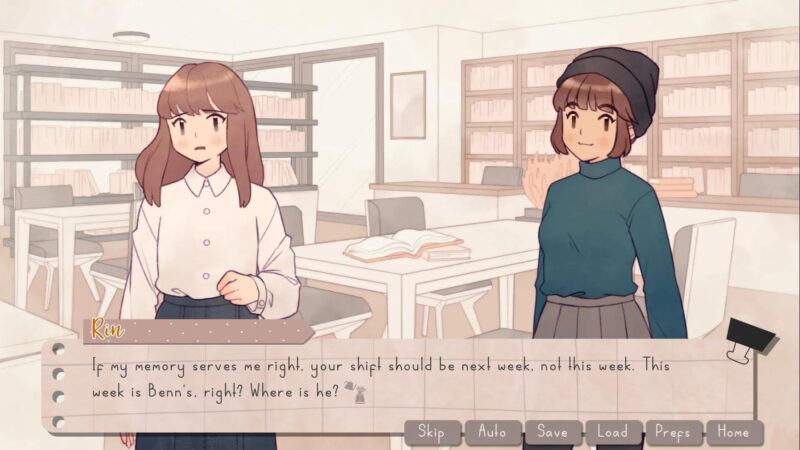EDDA Café is a freeware original English language visual novel created by Mushroomallow Studio, a visual novel studio based in Indonesia. The final version was first released on Itch.io on August 7, 2021 after being started for Itch’s Valentine’s Game Jam severan months earlier. It is available for PC (Linux, Windows, and MacOS) and Android. The short visual novel follows a young woman named Mina who is haunted by a certain event two years prior when she had said some regretful things to someone she cared about and, due to a tragic accident, had never had the opportunity to apologize.
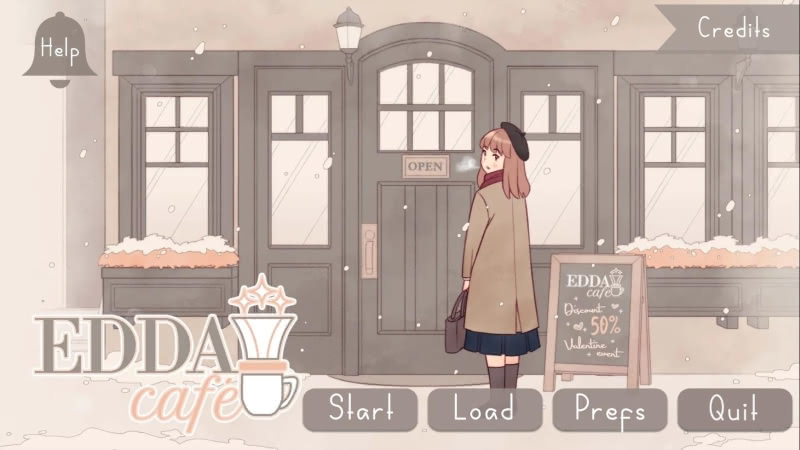
I reviewed visual novels close to Valentine’s Day in three of the four previous years. I decided to continue the tradition this year. However, unlike in the previous years, I wanted to find a visual novel that not only features romance but also features Valentine’s Day. EDDA Café had been peripherally on my to-do list for a while because I liked the art style in the screenshots. After confirming on its Visual Novel Database entry that Valentine’s Day plays a central role in the story, there was only one thing for me to do.
Before reading, note that this is a spoiler-free review. I will not discuss in detail any plot points beyond the general introduction provided by Mushroomallow Studio on EDDA’s Itch.io page.
EDDA Café Details
| Title | EDDA Café |
| Publisher | Mushroomallow Studio |
| Release | August 7, 2021 |
| Engine | Ren’py |
| Staff | Mushroomallow (Art); Nami (Writer) |
| Store | Itch (all versions) and Google Play Store (Android) |
| Resources | VNDB; Mushroomallow Website; Developer Postmortem |
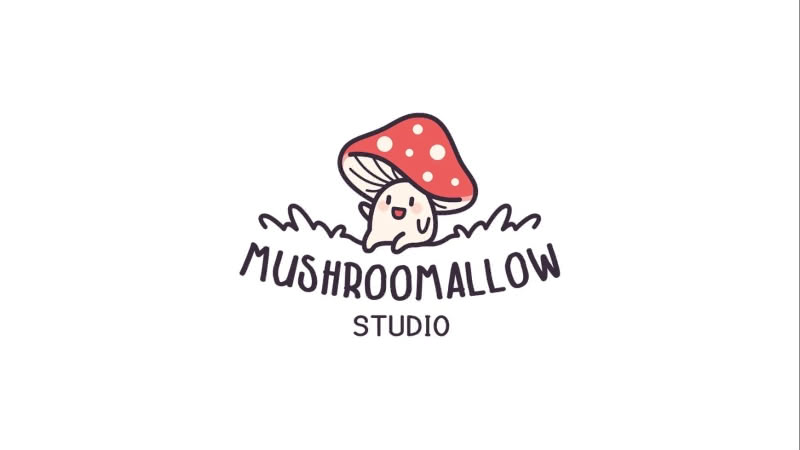
EDDA Café is available for Linux, Windows, MacOS, and Android. It is not available for iOS. My review is based on running the Linux release on my desktop computer. I tested it on my phone, which runs an Android-fork called LineageOS, and ran into no issues – so readers can choose between computers or Android devices.
(It should technically work on devices running Android derivatives – notably Kindle Fires.)
All versions of EDDA Café, including the Android release, can be downloaded from Itch.io. The novel is free to download but users can make an optional donation when prompted on the download. Android users can also obtain the novel for free from the Google Play Store instead of side-loading the .apk file from Itch.
It should go without saying that I read EDDA Café in English, but it is worth noting that Mushroomallow Studio was able to have it translated into Italian, Turkish, Canadian French, Metropolitan French, European Spanish, Russian, German, and Thai.
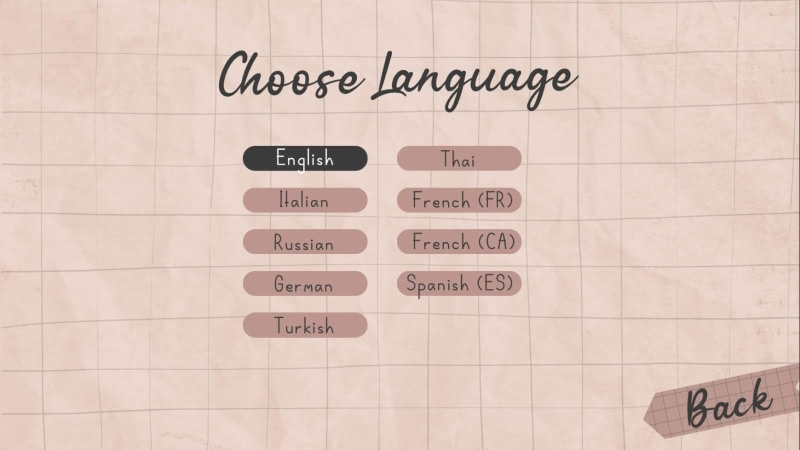
The player is prompted to choose a language upon first opening the novel. English is the default.
General Introduction to EDDA Café
I begin as always by quoting from the developer’s own introduction to the visual novel:
Follow the story of Mina in her struggle to move on from the past that haunts her since these past two years. She lost someone dear to her, and blamed herself for it. And now, on Valentine’s Day, she meets Taku, a waiter who introduced her to a cafe named EDDA. Dragged by her little curiosity and her friend’s compulsion, she finds out that through the magic in that cafe, she was given a second chance to relive her past.
The introduction then poses the question of the novel:
Will it save her heart? Will she move forward or stay in the past?
For being concise, this is an unusually detailed visual novel introduction. Having read through EDDA Café to 100% completion, I have no disagreement with how the developers describe the story other than to note that I would have probably been slightly less detailed were I to have been consulted.
EDDA Café Review
Below, I will review the different parts of EDDA Café.
Note that I will refer at times in the review to the developer’s postmortem, which was written after the release of the novel. You can find it here. Note that while the postmortem is careful to not spoil the ending of EDDA Café, it does feature some screenshots from later stages in the novel than what I opted to include in this review. If you plan to read EDDA, I recommend saving the developer’s postmortem for after the fact – but reading it beforehand would not meaningfully impair one’s enjoyment of playing EDDA in the first instance.
Estimated Reading Time
I clocked in at an hour and one minute with EDDA Café, but that included a couple of breaks and my taking and naming the screenshots you see in this article. I will estimate that it should take most careful readers somewhere in the 35-50 minute neighborhood, depending on reading speed.
Structure and Mechanics
EDDA Café is an entirely kinetic visual novel for about 90% of its reading time, meaning there is no player interaction beyond advancing the text. It has a single decisive choice close to the end of the novel, with each option leading to a different ending. I reviewed a novel with a nearly identical structure (kinetic until a single meaningful choice close to the end) on Valentine’s Day 2023 in A Winter’s Tale.
The reader can create a save point on the choice selection. Given the proximity of the choice to the ending of the novel (both routes, so to speak, are very short), it is easy to see both endings in just a few minutes after reading the choice.
EDDA provides only six save slots, which is relatively low in light of the fact I have looked at some even shorter visual novels with more saves on offer. However, six save slots is more than enough when one considers how short EDDA is, that it has skip functionality, and also that a save is only needed on the single choice to complete the novel efficiently.
Visuals
I was initially interested in EDDA Café because I liked the preview art I saw for it, and I came away from actually playing it very impressed with its aesthetic and level of polish – especially for a free game. With that being said, the team’s limited resources led to a few visual compromises that I will note here.
Let us begin with the characters. EDDA Café has four characters with portraits – but I will only feature three of the four in this review in the interest of not discussing more of the events of the novel than necessary.
Mushroomallow, who did the art, explained the team’s art concept in the Postmortem:
We decided from the start that we don’t want to use generic anime manga style for EDDA Cafe because it takes longer to draw and it’s not as unique. At the time, Nami suggested several artworks and a webtoon titled Super Secret by eon that became one of the art style references for EDDA Cafe.
The art style is interesting. I agree that it is not anime manga style – but it still has an air of being from the Japanese visual novel tradition despite not being Japanese. While it is not realistic per se, the designs are more realistic than what one may associate with the norm in Japanese and Japanese-inspired visual novels. The characters remind me somewhat of the designs in My Black Cat, which went for flat, somewhat realistic characters – but the quality in EDDA Café is much higher.
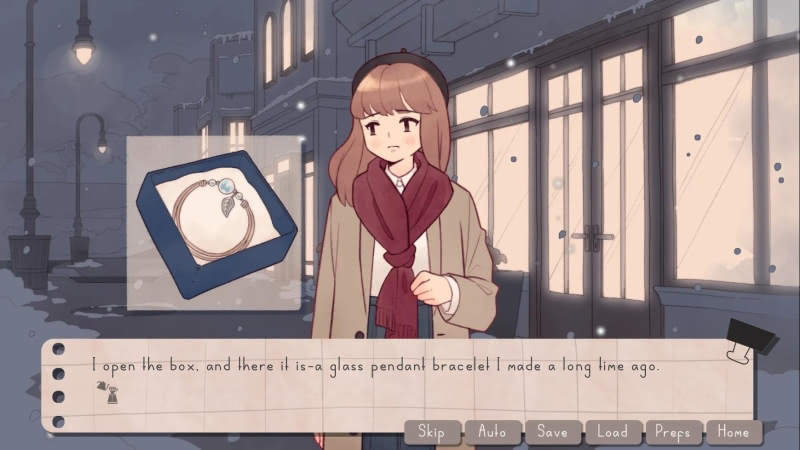
The character we spend the most time is the view-point protagonist, Mina. I return to the Postmortem for an explanation of how her design came to be:
It took several tries until we came out with the current design of Mina, the main character of EDDA Cafe. When we’re finally satisfied with her color palette, we found this adorable artwork on Pinterest … that became the base reference for background artworks in the game.
(Archived image of Mina’s Pinterest inspirations).
I like Mina’s designs and outfits. Mina is introduced to us as a college student and we are led to believe that she is probably in at least her third year. Mina is some combination of pretty and cute while also looking like a subdued and stylish adult. Her blouse, long skirt, and brown coat fit her soft-spoken, serious, and melancholy personality. I think her full outfit with her coat and scarf is the strongest, but they all look good.
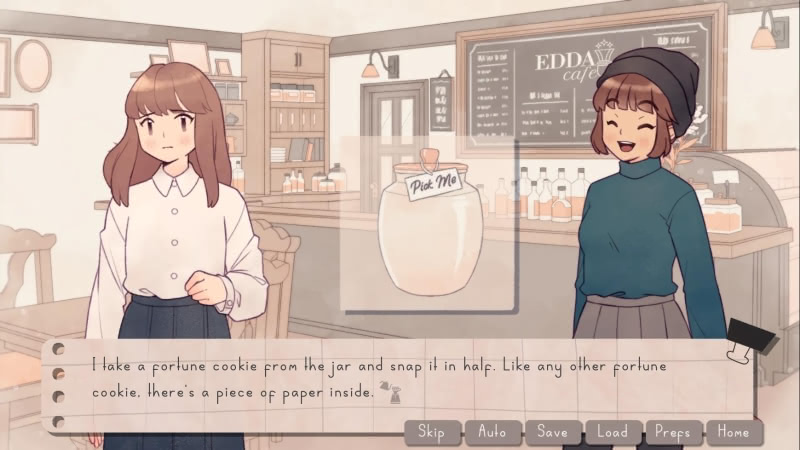
While Mina is soft-spoken and understated, her friend Rin is (too) high energy. Rin also has good design that sets her apart from Mina and seems to fit her personality. Rin has shorter, with more sporty hair, a bright yellow down jacket, shorter skirt, and knit cap. She is also a stylish young woman but with a different look than Mina.
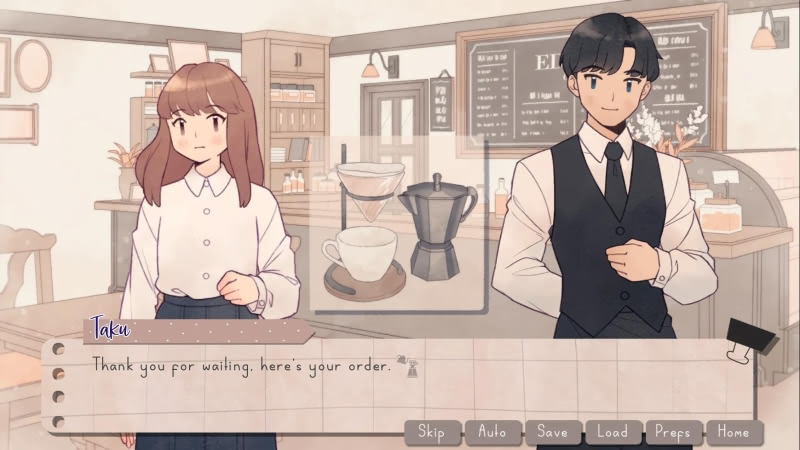
Finally, we have Taku – the waiter at EDDA. He is dressed the part and clearly drawn to give off a dignified, handsome air – which I saw in the comments marked him as the most popular EDDA character with some readers despite his relatively small role.
The character designs had one flaw, however. Let us return to the Postmortem:
MadScientist [the scripter] compromised the animation and asked the artist to provide a set of expressions in one .png image to make the scripting easier.
The characters, especially Mina, have many facial expressions. However, as you can see in my selected screen-shots, their poses never change, only their expressions and sometimes their outfits. While the team had a good reason for deciding on a single pose for each character given the constraints they were working under – some variety, especially for Mina, would have been welcome. On the plus-side, they chose reasonable default poses for all of the characters – from Mina’s somewhat apprehensive pose to Taku’s dignified appearance – in light of the fact that each character only has one.
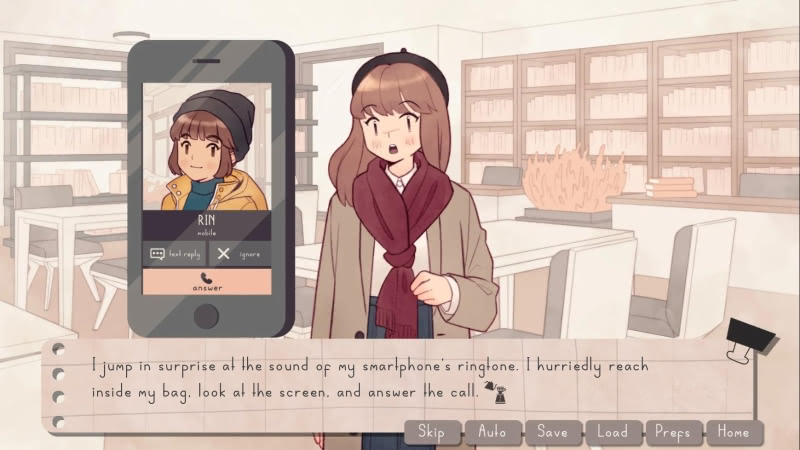
EDDA does not have a many locations and thus does not have many backgrounds, but count me as a fan of the background work. Mina’s clothing color pallet – browns, brownish-reds, grays and whites, dominate the backgrounds. The subdued watercolor-esque designs fit the mood of the novel and give the entire piece, including the scenes that do not take place in the EDDA Café itself, a café aesthetic.
(There are a few special effects thrown in – most notably snow – and the effects all look solid.)
Another major point in EDDA’s favor is its UI design. Let us turn to the Postmortem to learn what was behind that:
EDDA Cafe was meant to be a traditional visual novel, meaning there are no game mechanics involved aside from picking a choice, so Ren’Py was chosen for its simplicity. Ren’Py default user interface (UI), however, felt boring and we felt that we could modify it deeper to make it match more with the story and artworks. For that reason, MadScientist volunteered to do an overhaul (complete modification) to the EDDA Cafe’s UI.
The UI looks terrific and the colors match the novel’s overall visual style. Note how the text box appears to be part of a page from a notebook.
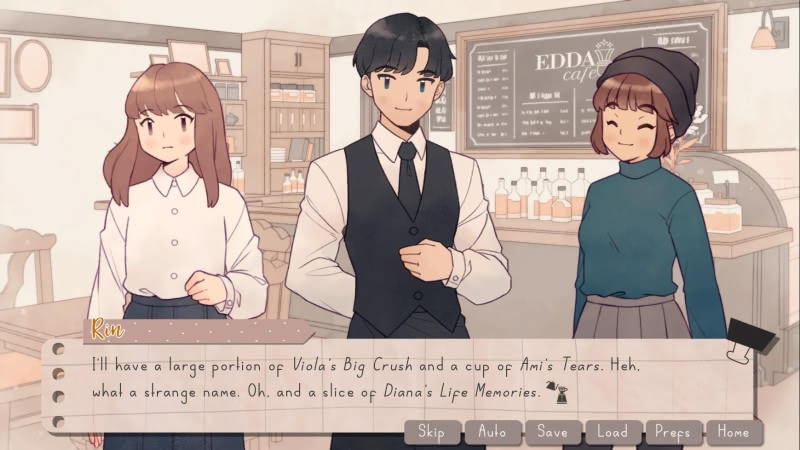
Speaking of the text box, I appreciate the little coffee set-up arrow-replacement in the text box. You can see it in all of my screen-shots.
The save menu is also very aesthetic.
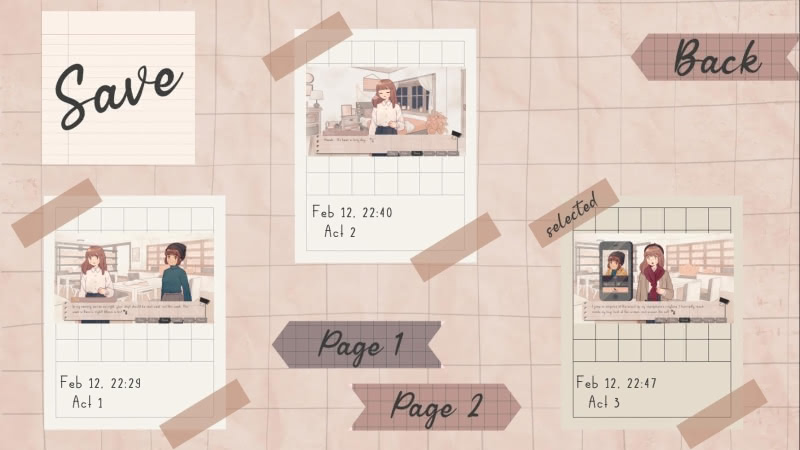
I do have one minor UI complaint. While I like the font choice and think it fits, the lower-case f’s took some getting used to. See an example below.
It took about three or four of them for my eyes to adjust – something about how far they dip and the fact that the cross comes close to creating a circle with the top of the f. In the end, however, this was a minor quibble.
Music and Sound
While team Mushroomallow went all in on the visuals, they used freeware tracks for the music and sound effects. See the Postmortem’s explanation:
We’re ashamed to tell you that sound effects and soundtracks were thought at the later part of the development (sorry to audio people!). We found great royalty free piano tunes that we thought matched with the story along with some sound effects that we found on various websites. Some sound effects had to be tweaked a bit, but overall we’re pretty happy with the sounds that we’ve found.
Most of the freeware doujin Japanese visual novels I reviewed as part of my al|together project also used freely available music (some of which appeared in multiple, unrelated novels), so there is no shame in following tradition. On the whole, while EDDA Café lacks a standout music track (they ran together for me), I agree that the piano-based music was appropriate for the story and provided a suitable complement. The limited sound effects were all well-used.
One sound issue I will fault EDDA on is choosing to voice a few of Taku’s lines. Taku gets voicing for things such as saying WELCOME, but not his normal dialogue. The sound has quality control issues and randomly voicing a couple of lines feels out of place. While it is a minor issue since Taku only gets a couple of voiced lines, readers will not miss anything by turning off character voices in the novel’s menus.
Language Point
Before my analysis – I will note an interesting language point. While EDDA Café is an original English-language visual novel, neither the writer nor the project leader, both whom are based in Indonesia, are native English speakers. See the Postmortem:
None of us are native English speakers and we simply thought it’s easier to communicate in local language with the team to reduce the possibility of miscommunication. EDDA Cafe was developed with English language in mind, so the decision of an all-local team was not without hurdles. Here’s where Leporine, our English native-speaker editor, came to the rescue.
I have reviewed a couple of English language visual novel translations, namely LoveChoice and Bad End, and both had some English difficulty. With respect to EDDA, it fortunately does not read like those translations and there were no points that I felt like I was reading something written by people who do not have a practical command of English. There were no particularly jarring turns of phrase. However, as I will get into in my review of the writing proper, the writing quality did vary and there were points where I thought the phrasing was a bit stiff. That is – it generally read well but the way the characters spoke felt less natural than the three previous original English language novels I reviewed, two commercial pieces in ACE Academy and Kaori After Story and a freeware piece in Save the Date.
Story and Writing Quality
In this section – I will offer my subjective take on the story and writing quality as best I can without spoiling anything in the story that is not highlighted by Mushroomallow Studio on the Itch.io page for the novel.
It is important for short visual novels such as EDDA to be focused. There is only so much you can do and so many characters you can introduce in a 12,000 word (the Studio’s approximation of the novel’s length) piece. To its credit – EDDA is generally laser focused on its theme and message.
We meet Mina on February 12, 2025 – and discover that she harbors great regrets about something that happened in the not-so-distant past. The novel makes it obvious in her first appearance with the appearance of a bracelet that she made that her regret has to do with a past love. Although EDDA holds off on the precise details of what happened until the latter stages of the novel, we come to understand that Mina had a fight of some sort with someone she cared about, said things she regretted, but she had never had a chance to make amends because that had person died before they could speak again.
EDDA introduces Mina’s problem with sufficient clarity in its first couple of scenes and uses Mina’s friend, Rin, to hammer home her precise struggle. Mina cannot forgive herself for what she said to the person she cared about, and she is haunted by the fact that those were the words she parted from him with. These regrets cast a shadow over Mina and prevent her from enjoying life or looking forward to her future. Whether the person she cared about and who presumably had cared about her would want her to be haunted like this is beyond the point for Mina so long as she cannot make peace with what happened.
The novel also makes clear early that the in-game EDDA Café is no normal Café. We learn that for some reason, not everyone can see it, and the mysterious Taku makes some interesting statements about its menu. In light of the fact that Mina’s opening monologue in the novel references an urban legend she heard from Rin about being able to go back in time – most readers should pick up where the Café part of the plot is going.
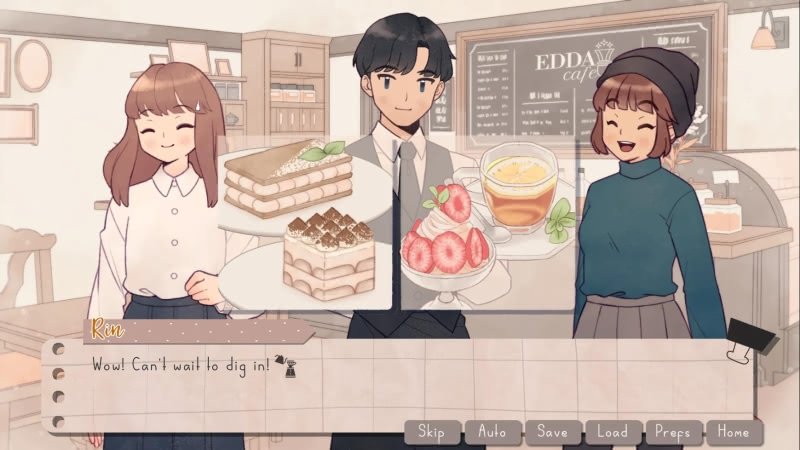
I obviously will not discuss the novel’s conclusion in too much detail, but I can say enough to accomplish a good review without ruining the ending for prospective readers. First, I quote from the Postmortem:
The last ⅓ part of the story was the hardest to write as we wanted to make sure that the conflicts in Mina’s heart could be resolved in a satisfying manner, both for us and for the readers.
Here, we learn that the team behind EDDA went in with the objective of telling a self-contained story that would resolve the conflicts in Mina’s heart. This is not always the objective of short visual novels. For example, I reviewed an interesting and even shorter piece in From the Bottom of the Heart, which I argued in a review explicitly concluded with a new beginning instead of wrapping everything up. Knowing that EDDA’s objective was to thoroughly resolve Mina’s internal conflict, we can evaluate how successful it was.
First, I will air a few issues I had with the last 1/3 of the story without specifically saying what happened (not that it should be hard for most people to guess the general outline). While I thought Mina’s central conflict itself – the reasons for her suffocating unease – was reasonable and well thought out. That she lost someone she loved and lost him immediately following an ugly fight is more than enough tragedy. Mina had an adult problem – grown up regrets – and it would have been interesting to see her have to grapple them without additional, not unforeshadowed twists thrown in right at the end of the novel. I will characterize what happened as an excess of tragedy – but that extra tragedy had the unexpected effect of shifting the heart of Mina’s perspective in a way that did not do the novel’s conclusion any favors.
I reviewed a parody freeware visual novel called Plain Song Christmas Special which itself parodied a novel called Plain Song (both Plain Songs were written by the same person). Christmas Special made light of many trends in visual novel story telling with one being the excessive use of tragedies – sometimes tragedies that stretch belief – to move the plot. Tragedies can make things simultaneously harder on the characters and easier on the writers. This would have been thecase in EDDA but for the fact that here it actually made things easier on the characters.
I had a second reason for bringing up the Plain Song duo, however – and here I will favorably contrast EDDA’s conclusion with Plain Song. Plain Song was a romance visual novel that I liked very much through about 4/5 of its script. I complained that Plain Song’s decisive, end-game choice, was a failure because it entirely ignored one of the central themes of the novel – communication. EDDA does not make communication an explicit focus for most of its story, but highlights the issue very nicely in its conclusion and in a way that feels natural. A dry explanation of what led to Mina’s particular species of malaise is a failure of communication – her having apparently lost her cool, feeling instead of understanding, without considering that cruel events can make it impossible to take words back and make up afterwords. Without going into too much detail, one thing that looms in the background for much of the novel is precisely what occurred to prompt Mina to say whatever it was that ended up turning her world gray. While I had issues with some of the twists in the ending – its handling of the importance of communicating one’s feelings clearly and making an effort to understand people you care about and consider what their feelings actually are instead of what you perceive them to be was welcomely well-done.
EDDA’s dual ending approach was interesting, albeit one of the endings feels more natural than the other. The late-game choice leads to one of two dramatically different outcomes – granting that the choice also comes right at the end of the novel, so the dramatically different endings are cursory. One ending matched my perception of what the proper ending – in line with EDDA’s themes and message – should be. However, both endings are portrayed as acceptable, if not good, and the novel takes a non-judgmental position on which one is the proper choice. But for the fact that the novel itself did not take a stance, it reminded me of My Black Cat, where the writer created three variations of the ending (the choice structure was more involved in My Black Cat) but identified one as being the first, original, and closest thing to a true ending in his postscript.
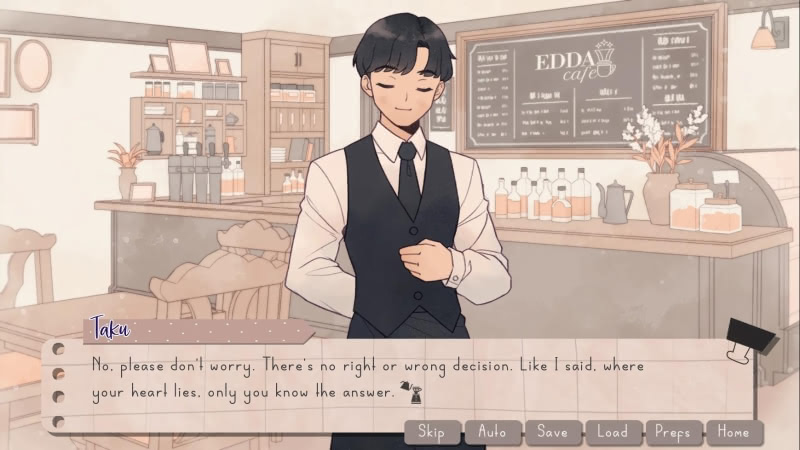
While I think one of EDDA’s endings made more sense – the second ending felt more credible than I would have expected had I been told about it before reaching it, albeit it is the weaker of the two endings because EDDA’s scope was too narrow to expand on the idea of how to handle gaining a new perspective on a past event. Moreover, the lesser of the two endings suffered somewhat from being more dependent on the ill-advised late-game twist.
As a structural matter – rather than a writing matter – placing the choice so close to the end of the game does weaken its effect a bit. As I noted in my section on structure, it is possible to see both endings in about 6-8 minutes with a strategically placed save point on the final choice. Seeing both endings in such quick succession (and I will venture this is how most readers will see them) lessens the weight of Mina’s choice. I would have personally stuck with a single ending and used the extra time to deliver a longer postscript, but EDDA’s choice (pun intended) was reasonable and it tied it into something the novel introduced about the Café in a clever way.
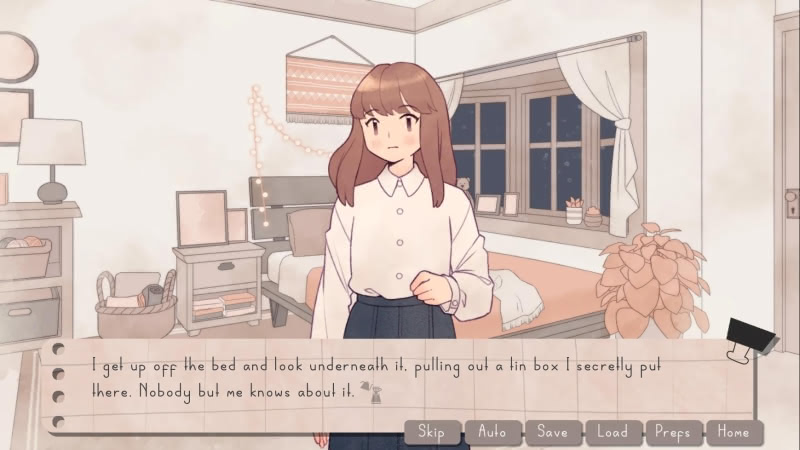
I will conclude my writing analysis by highlighting my favorite scene of the novel. While there is no spoiler here about the novel’s conclusion, feel free to save this paragraph for later if you want to read the novel without knowing my favorite scene beforehand. Toward the middle of the script, we have a scene with Mina alone in her room, going through some of her belongings that remind her of the past. Save for a brief breakdown the day earlier, we see that Mina has a depressed air in public, even around her friends, but that she holds herself together and is pleasant to those around her (Rin can be a bit exhausting, so credit to Mina). As Mina goes through her stuff in her room, her initially happy reminiscence leads to her unexpectedly (to her) beginning to tear up. This was a very well-done scene in context – Mina alone, at home, close to an unhappy anniversary and coming off a day where she nevertheless tried to put on a happy face – finally being overcome by emotion. It also featured the most delicate writing of EDDA and, despite there being more dramatic scenes in the latter half of the novel, stood out as the strongest moment of the piece.
Extras
Completing EDDA Café unlocks a Gallery. The Gallery has three sections: Characters, CG, and Others. The character section features each of the first three introduced characters with brief descriptions. See Mina below:
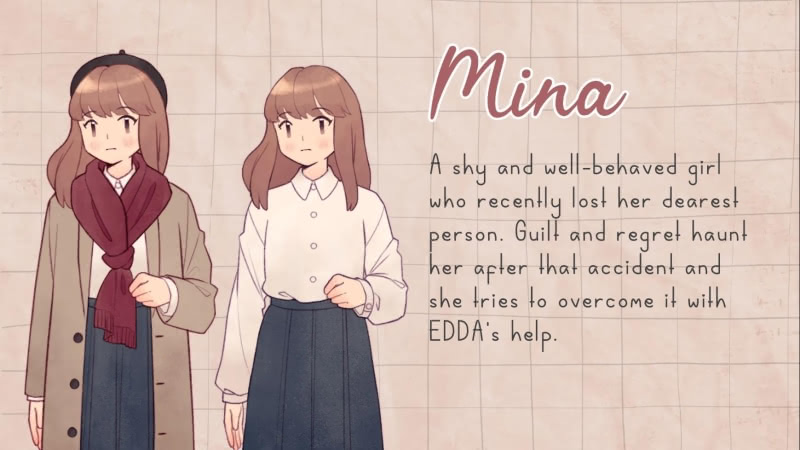
There are only two CG scenes in EDDA. Both come at the end of the novel, so I will omit discussing them here.
The “Others” section is the highlight of the gallery. This includes the two title screens that are unlocked upon completing one of the novel’s two endings and several promotional images from before and after EDDA’s release. I will share one of the promotional images since it came out before the novel was available for download.
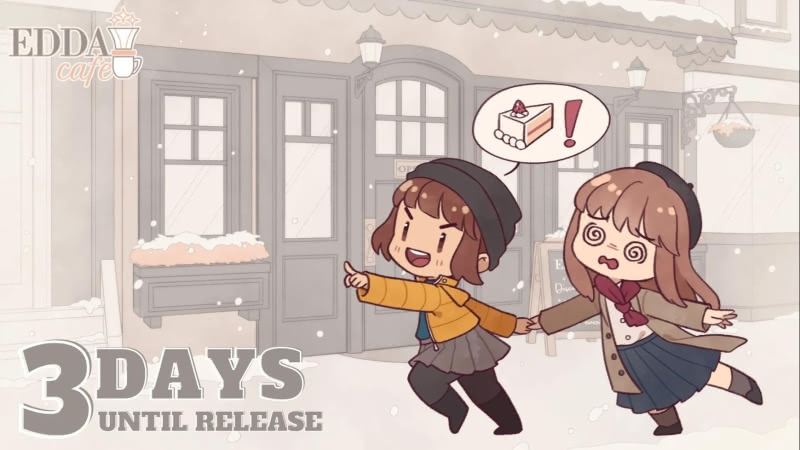
Finishing the novel also unlocks an credits screen. Because EDDA is a good visual novel effort, I recommend staying and taking the time to read the very short 1-screen credits.
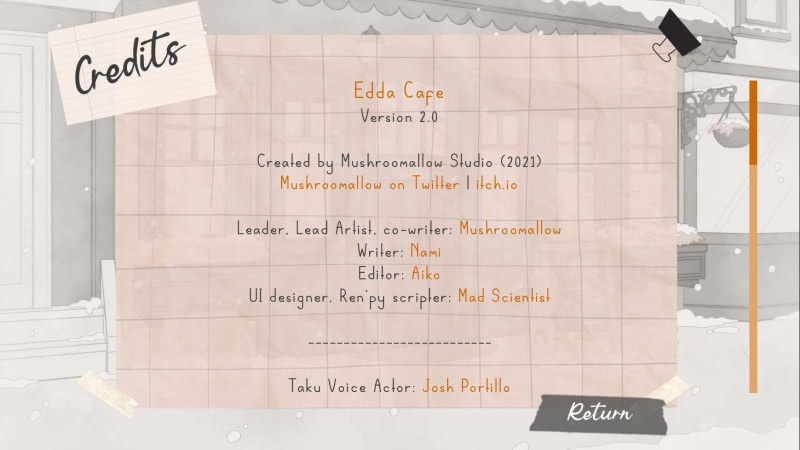
I would have liked to see a chapter jump menu as well, but EDDA is short enough that it is easy to skip around to see a scene again.
Title Screens
As I noted above, the default title screen changes upon completing one of the two endings. Each of the endings has a title screen attached. I think the two extra title screens feature the best art in EDDA Café, with the one featuring Mina and Rin being my favorite piece of the project and doing a great job of capturing the spirit of the ending to which it is attached. I will not share them here for spoiler reasons – but they serve as charming wordless epilogues in a way.
I did note an interesting behavior with the end-game titles (note this is for PC, I have not tested on Android yet). If you complete ending A, the default title screen is replaced with Title-A. However, if you then complete ending B, the Title-A ending is replaced with B. In this way, you can change the title screen based on which ending you complete last. However, if you close the game and open it anew, you see the default title screen that is not attached to either ending. This can be changed by completing an ending again.
Conclusion
EDDA Café is a very polished effort for a first-time freeware visual novel put together by a team of four people. Although I do not use a rating system for these kinds of reviews, I give EDDA a solid recommendation.
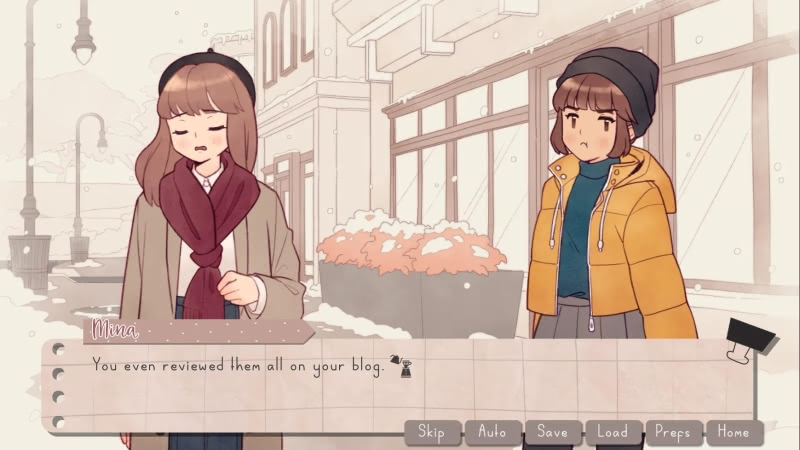
It is short, free, and available cross-platform. The charming art and strong aesthetic sensibilities are more than worth the free price of admission, and that it runs cross-platform (essentially everything except iOS) is another feather in its cap. While I had some critiques of instances of inelegant writing and of decisions it made late in the story, EDDA’s story is solid on the whole and it reaches satisfactory conclusions for its sympathetic view-point character. If you enjoy the screen-shots and thought my review made it sound interesting enough, I encourage you to spend an hour or so visiting the EDDA Café.
